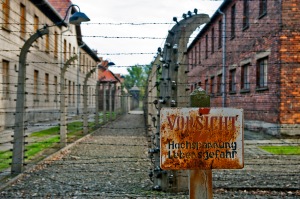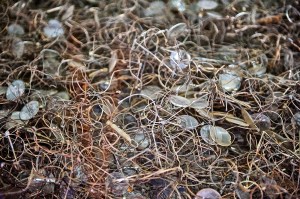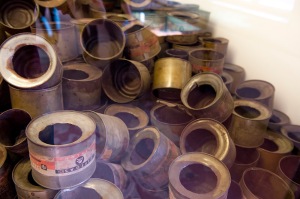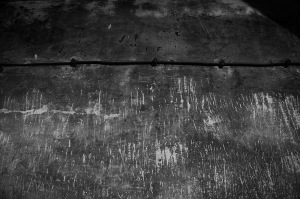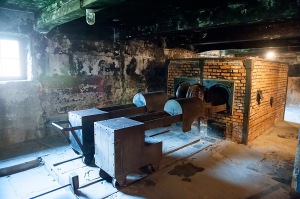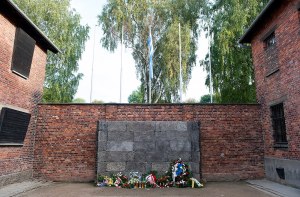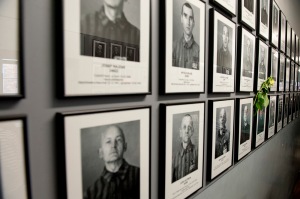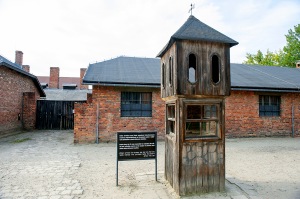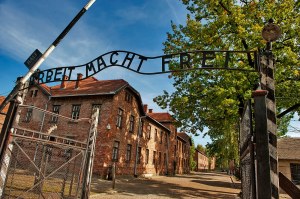Hello, and welcome to the second post in my two-part series about my trip to the Auschwitz Museum in Poland. If you missed the first part you can read it here. It focused on Birkenau, the part of the Auschwitz Museum you can access for free. It’s also the part where the camps were.
This part will focus on the paid-entry part of the museum. If you aren’t sure how to get to Auschwitz from Karkow definitely read my first post. It’s not super difficult, but it helps to know what you’re doing.
In keeping with the theme of the barbed-wire fencing we travel now to the main Auschwitz camp itself. The fencing at the main Auschwitz camp was electrified. It may have been the same story at Birkenau, but I don’t know. Much like Terezin, Auschwitz was a re-purposed military garrison. Most of the buildings were barracks for the Polish army.
The Germans did their level best to turn the place into a city of sorts, but there are definite prison motifs throughout.
When your building is described as a “block” there aren’t a lot of options as to what it could be. So many of these building have been cleared, cleaned and converted into museum spaces that the feeling is completely different from what it once was. That is why I say Terezin is so much more poignant. In Terezin it feels like the Nazis just packed up and split. They threw open the doors and fled and that is how things stayed. Being there is like walking through a tomb. Auschwitz is very much different.
There are some impressively sad displays at Auschwitz and it’s something everyone should remember and see at least once in his life. Will I return? Maybe, I didn’t feel much sorrow or pain here and feel a touch indifferent about Auschwitz proper.
Displays like the shoes above have been expertly curated to make us feel something about the scope of the horrors that occurred in this place, or more accurately in nearby Birkenau. The way they are done, to me reduced their effect. A pile of thousands of shoes behind glass is impressive, but knowing it’s only a fraction of reality made it feel sanitized for me.
A bit more effective was this display of glasses. But still, they are just things. Things which define humanity yes, but so far removed in time and strategically placed that they have a diminished impact for me.
Even this display of used Zyklon B canisters just didn’t have me tearing up. Things did start to get real however when we were ushered into a room full of human hair and then told that the Nazis made a hefty profit reselling the hair from dead prisoners for industrial purposes. Firstly, I had no idea hair could be used for so many things and secondly; humans, no matter what their status, are not livestock and to treat them as fodder for industry like sheep or cattle is offensive at best.
What you see above is the only place that was truly saddening for me. The Germans took and old Polish powder magazine and used it to test just how effective Zyklon B was. There were small holes in the roof and SS troopers stood atop it, punctured the canisters and dropped them inside. This place is where the most repulsive element of the Final Solution was perfected. It is the first gas chamber. The gas was tested in the basement of one of the blocks first, but this was the first place where they really got things working right. I will not speculate about what those marks are on the wall. I will let you draw your own conclusion, but those marks are one of the few things in Auschwitz that have not been deliberately placed there to move you and that makes them some of the most horrible marks in the history of man.
Within sight of the gas chamber are the ovens used to cremate those who met their unfortunate end inside.
Now, before people were gassed, some met their end by firing squad. This happened to relatively few people though. Still there were special areas set up between barracks for the purpose. This one is a reproduction as well as memorial. I doubt you can see them, but there were a few tiny Israeli flags stuck in this one.
In the beginning the Nazis also photographed and registered everyone who came to the camp. This task became too great when thousands of people were arriving by rail each day, so the photographing didn’t last too long. I imagine those who went directly from the train to the gas chambers were not registered in any way. Perhaps a mere count of people is all that was done.
This isn’t to say that life at Auschwitz proper was hunky dory. The structure you see above was built so that the guards who took roll wouldn’t have to stand in the weather when they counted prisoners. Talk about being wussies. I think you can read the sign in the photo. The idea of it to me was offensive.
And then of course we have the main gate. The famous “Arbeit Macht Frei” sign. “Work makes you free.” I don’t think any blog post about this place would be complete without a photo of this sign.
My trip to Auschwitz and Birkenau was informative and something I recommend to everyone. Go, see it, but have something else planned for the next day that is a little happier — like the salt mine; which you will be able to read about soon.
Stay tuned and thanks for reading!

